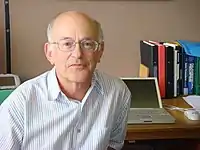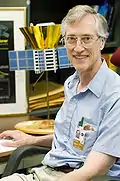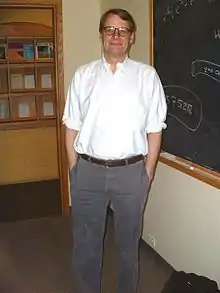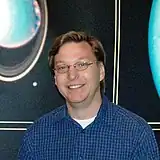Marc Aaronson Memorial Lectureship
The Marc Aaronson Memorial Lectureship, also known as the Aaronson Prize, is an award of the University of Arizona Department of Astronomy and Steward Observatory which promotes and recognizes excellence in astronomical research. It is named after astronomer Marc Aaronson, who died in 1987 in an accident while making astronomical observations. He was 36 years old.[1]
Background
The lectureship and cash prize are awarded every eighteen months to an individual or group who, by his or her passion for research and dedication to excellence, has produced a body of work in observational astronomy which has resulted in a significant deepening of our understanding of the universe. Any living scientist is eligible for this award without consideration of race, sex, or nationality. Fourteen previous Aaronson Prize winners are returning to Tucson on Apr 3–4, 2017, for a scientific symposium[2] in Marc's honor.
Aaronson came to Steward Observatory as a postdoc after receiving his PhD degree from Harvard in 1977 and became an Associate Professor in 1983. His astronomical research focused on many of the most important problems of observational cosmology: the cosmic distance scale, the age of the Universe, the large-scale motion of matter, and the distribution of invisible mass in the Universe. Aaronson made important contributions to the understanding of stellar populations in the Large Magellanic Cloud. In recognition of his research achievements, Aaronson was awarded the George Van Biesbroeck Award by the University of Arizona in 1981, the Bart J. Bok Prize by Harvard University in 1983, and the Newton Lacy Pierce Prize by the American Astronomical Society in 1984.
Recipients
Source: University of Arizona
| Year | Recipient | Award Citation | |
|---|---|---|---|
| 1989 |  |
Robert Kirshner[3] | For studies of supernovae, supernova remnants, and the large-scale distribution of galaxies |
| 1990 |  |
Ken Freeman[4] | TBD |
| 1992 | John Huchra[5] | For surveys that led to the discovery of large-scale structure in the distribution of galaxies | |
| 1993 | Nick Scoville | TBD | |
| 1994 | .jpg.webp) |
Wendy Freedman[6] | For a decade of fundamental contributions to the areas of the extragalactic distance scale and the stellar populations of galaxies |
| 1996 | J. Anthony Tyson[7] | In recognition of his use of new technologies to make pioneering contributions in observational cosmology | |
| 1998 |  |
John C. Mather[8] | For the conception, design, and execution of a seminal cosmological observation, the measurement of the infrared background with the COBE satellite |
| 1999 |  |
Bohdan Paczyński[9] | For his theories of gamma-ray bursts and for his work on microlensing |
| 2001 |  |
Ewine van Dishoeck | For her comprehensive attack on the problem of chemical evolution of star-forming regions[10] |
| 2002 |  |
Geoffrey Marcy | For his pioneering work on low-mass stars, and for his discovery of more than fifty planets orbiting other stars[11] |
| 2004 |  |
Lyman Page | For his decade-long series of state-of-the-art experiments aimed at the discovery and characterization of degree-scale temperature anisotropies of the cosmic microwave background radiation[12] |
| 2005 |  |
Brian P. Schmidt | For using observations of Type Ia supernovae to discover that the Universe's expansion is accelerating[13] |
| 2007 | Andrea Ghez | For her use of speckle and AO and IR imaging to further our understanding of the dark object in the Galactic Center (the supermassive black hole) and for her work on star formation and evolution of pre-main-sequence objects[14] | |
| 2008 |  |
Mike Brown | For his outstanding research and lasting contribution to astronomy through the characterization of the outer solar system and the discovery of objects comparable to Pluto[15][16] |
| 2010 |  |
J. Davy Kirkpatrick | For his outstanding research and lasting contribution to astronomy through the discovery and characterization of the lowest mass stars and brown dwarfs[17] |
| 2012 | Pieter van Dokkum | For his studies of the evolution of the most massive galaxies over cosmic time | |
| 2014 | Alice Shapley | For her contributions to the study of how galaxies form in the early universe | |
| 2015 | Vasily Belokurov | For his discoveries of structures in the Milky Way through data-mining of large surveys | |
| 2019 | Jenny Green | For her work on black holes | |
See also
References
- "MARC A. AARONSON, ASTRONOMER, KILLED BY REVOLVING DOME". NY Times. 2 May 1987.
- "Aaronson Prize 30th Anniversary Symposium".
- "Robert Kirshner".
- "Ken Freeman".
- Overbye, Dennis (13 October 2010). "John Huchra". The New York Times.
- "Dr. Wendy Freedman". Archived from the original on 2012-05-08.
- "LSST Director". Archived from the original on 2012-09-04.
- "Dr. John C. Mather". Archived from the original on 2011-05-22. Retrieved 2012-02-04.
- Dziembowski, W. (2007). "Bohdan Paczyński". Publications of the Astronomical Society of the Pacific. 119 (858): 836–841. doi:10.1086/521711. JSTOR 10.1086/521711.
- "Eminent Dutch Astronomer to Give April 20 Aaronson Memorial Lecture | UANews". UA News. Archived from the original on October 24, 2007.
{{cite news}}: CS1 maint: unfit URL (link) - "World Famous Planet Hunter". UA News. Archived from the original on August 1, 2012.
{{cite news}}: CS1 maint: unfit URL (link) - "Light from the Edge of the Universe". UA News. Archived from the original on July 17, 2012.
{{cite news}}: CS1 maint: unfit URL (link) - "The Accelerating Universe". UA News. Archived from the original on July 16, 2012.
{{cite news}}: CS1 maint: unfit URL (link) - "Milky Way's Black Hole". UA News. Archived from the original on October 10, 2007.
{{cite news}}: CS1 maint: unfit URL (link) - "Mike Brown blog".
- "Planetary Astronomer Michael Brown to Give Aaronson Memorial Lecture". UA News. Archived from the original on September 3, 2012.
{{cite news}}: CS1 maint: unfit URL (link) - "Secret Lives of Brown Dwarfs". UA News. Archived from the original on June 19, 2010.
{{cite news}}: CS1 maint: unfit URL (link)